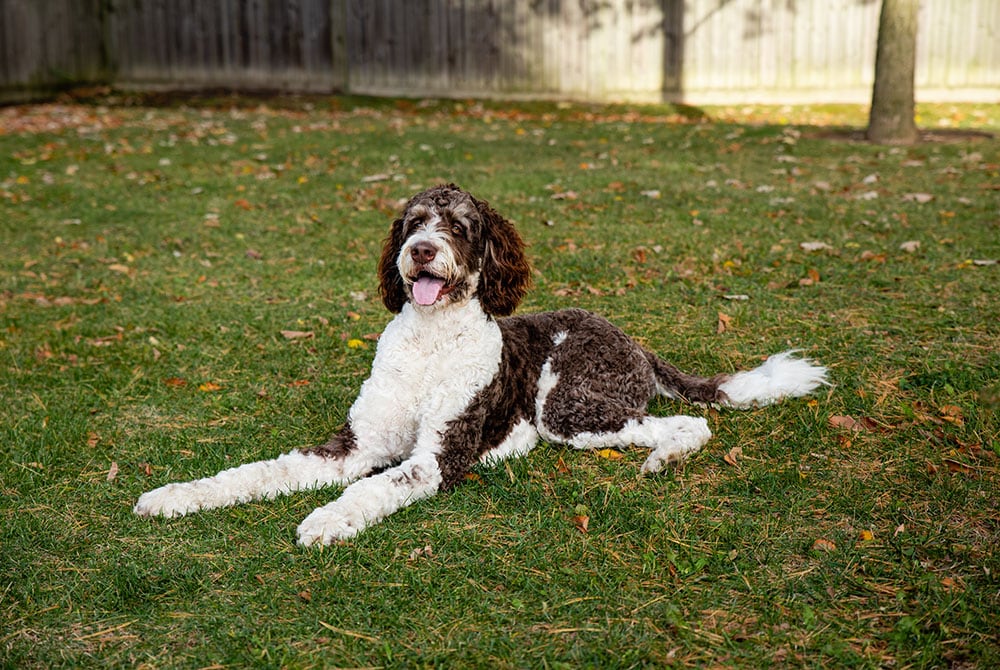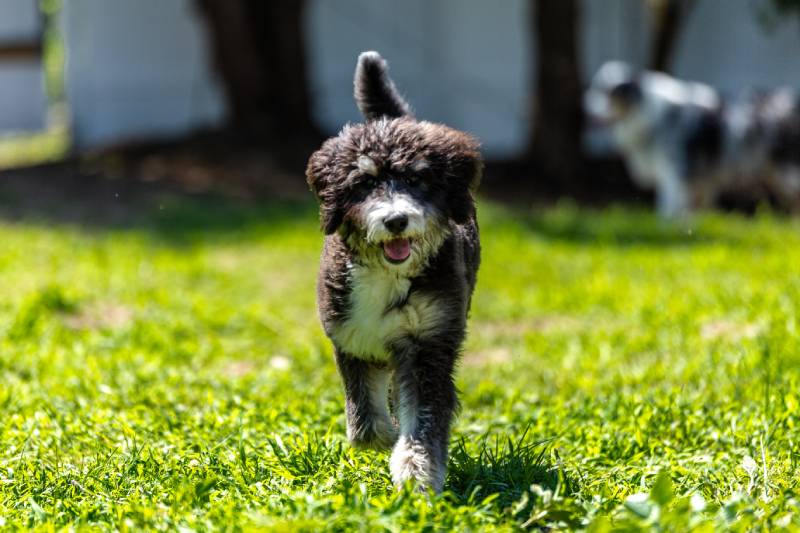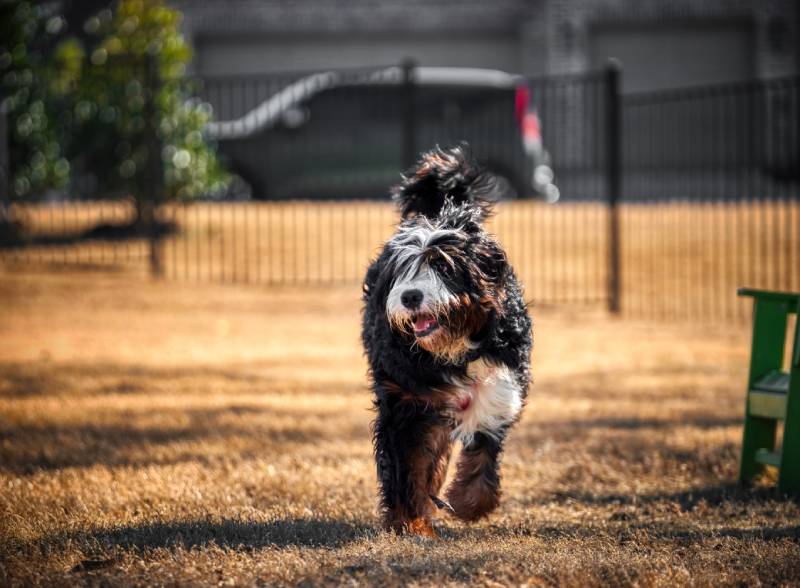How Big Does a Bernedoodle Get? Average Weight & Growth Chart
By Hanh Duong
Updated on

Click to Skip Ahead
The Bernedoodle, which first appeared in 2003, is a cross between a Poodle and a Bernese Mountain Dog. They are funny, charming canines who enjoy lying on the couch as much as playing outside. They make the ideal family pet and are especially fond of kids. So, they can be cuddly lap dogs or an adventurous companion.
The weight and height of Bernedoodles can vary thanks to the Poodle’s bloodline. Fully grown you can expect a Bernedoodle to weigh: 30 pounds (from a Tiny Poodle), 53 pounds (from a Miniature Poodle), or 67 pounds (from a Standard Poodle). But we will explore their size and growth at all stages of their development in this post.
Bernedoodle Breed Overview
Most frequently, Bernedoodles are created from standard Poodles as it’s risky to cross giant breeds with small breeds. The breeding mother or puppies may suffer complications. Still, Bernedoodles are classified as standard, miniature, or tiny, depending on their size. They often have a wavy or curly coat like Poodles, but sometimes, a Bernedoodle can have a straighter coat that resembles that of a Bernese Mountain Dog. Fortunately, a breeder can predict each puppy’s coat type once the litter is a few weeks old, allowing them to match a suitable dog with the right owner.
As long as they receive plenty of attention and frequent outdoor time, Bernedoodles may comfortably live in apartments. And regardless of size, this hybrid is very kind and enjoys spending time with kids. These canines are very relaxed, so they don’t make ideal guard dogs because they rarely bark.

Bernedoodle Size and Growth Chart
You can find Poodles in three sizes: toy, miniature, and standard, and Bernedoodles can be found in these sizes, too. A standard Bernedoodle can weigh up to 67 pounds and stand up to 29 inches tall. A miniature dog often reaches 18 to 22 inches tall and weighs 48 to 53 pounds. A “tiny,” created from a toy Poodle, weighs only 27 to 30 pounds and stands between 12 to 17 inches tall.
| Age | Tiny | Miniature | Standard |
| 1 month | 6 pounds | 11 pounds | 14 pounds |
| 2 months | 10 pounds | 18 pounds | 24 pounds |
| 3 months | 14 pounds | 25 pounds | 33 pounds |
| 4 months | 18 pounds | 33 pounds | 42 pounds |
| 5 months | 20 pounds | 36 pounds | 46 pounds |
| 6 months | 22 pounds | 40 pounds | 52 pounds |
| 7 months | 24 pounds | 43 pounds | 55 pounds |
| 8 months | 26 pounds | 46 pounds | 59 pounds |
| 9 months | 27 pounds | 48 pounds | 62 pounds |
| 10 months | 28 pounds | 50 pounds | 64 pounds |
| 11 months | 29 pounds | 51 pounds | 65 pounds |
| 12 months | 29 pounds | 52 pounds | 66 pounds |
| 18 months | 30 pounds | 53 pounds | 67 pounds |
When Does a Bernedoodle Stop Growing?
As mentioned earlier, Bernedoodles come in three varieties, and each one matures at a different rate. Toy and tiny versions develop more quickly and often need between 8 and 12 months to attain their maximum growth potential. For larger pups to reach full size, it can take up to 14 months or even up to 2 years.

Factors Affecting the Size of Bernedoodles
Knowing when and how large your puppy will grow is crucial for responsible pet ownership. You can better prepare for adult life by paying attention to the variables that influence their growth rate and size.
Along with their gender and age, genetics, exercise, nutrition, and health all impact your pup’s growth. Feeding them a healthy diet that is tailored for their size and growth stage is key for proper growth. For example, puppies need more calories in general, so feeding them puppy-specific food is essential. Knowing this will enable you to provide healthy and happy care for your beloved animal. Be sure to give them lots of healthy food, playtime, and affection.
Ideal Diet for Maintaining a Healthy Weight
The recommended weight for pets will vary depending on their breed, age, and height. So, there is no one-size-fits-all healthy weight for animals. Generally, your dog’s diet should have a moderate fat content to prevent weight gain and a high protein content to maintain muscle mass. Leaner meat, like chicken, turkey, fish, lamb, or lean cattle, is the best choice.
It is also vital to consider the caloric value and energy density of the food you decide to feed them. Giving your dog a diet of only kibble is totally fine. But it’s a great idea to add real meat, fish, and vegetables to their meals to make it more nutritious.

How to Measure Your Bernedoodle
When determining how much your furry friend has grown over time or entering them in dog shows, knowing their height is a must. A dog’s height is calculated from the ground to their withers, which ensures an exact measurement each time. The withers are the highest part of their shoulder blades.
Always use a soft tape measure, and it shouldn’t be so tight that it alters your dog’s body form. Do it only when your dog is standing for the most accurate measurements.
Conclusion
We hope that this Bernedoodle growth chart was helpful to you and that we were able to assist you in finding the answers to all of your queries regarding growth in Bernedoodles. We know it can be challenging to understand some phases of their maturation from a puppy to an adult. Just be sure you’re up to speed on everything, including some things like adequate nutrition and good care that promote your pup’s healthy development.
If you have any more questions concerning your special Bernedoodle, don’t hesitate to consult a veterinarian and find the best solution.
See also: Newfypoo vs Bernedoodle: Differences & Similarities (With Pictures)
Featured Image Credit: Cavan-Images, Shutterstock














